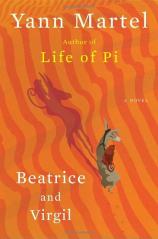Beatrice and Virgil
Review
Beatrice and Virgil
An internationally bestselling novel has elevated mild-mannered
Henry L'Hôte to celebrity status. Between speaking engagements
and world tours as a lecturer and popular talk show guest, Henry
spends three years writing a book about the Holocaust. Despite
cautionary, even admonishing suggestions that this is a subject
that readers no longer wish to explore, he is convinced that he has
found a new way to tell the story, and he produces a manuscript
that he thinks is brilliant. Henry enters a conference with his
agent, editor and publisher with high expectations of praise and
acceptance, and leaves with his hopes dashed. He has reaped the
whirlwind of his success and finds himself confronted with the
dreaded writer’s block. Having sown his seed, his harvest has
failed miserably.
Time weighs heavily, and when his wife is offered a lucrative
position in another city, they move to London. Henry continues his
routine of answering fan letters from his first successful novel
and trying to write. But staring at a blank page becomes so
demoralizing that in desperation he finds a part-time job as a
barista in a chocolate café, takes clarinet lessons, joins an
amateur theater group and takes long walks with his dog.
Henry continues to receive and answer fan mail, and among the
letters and packages that cross his desk is a thick parcel
containing quotes from an obscure Flaubert novel and a few pages of
an unfinished play that appears to be an original. The Flaubert
excerpts are so violent and disturbing that he lays it aside at
first. But a brief attached note at the end of the unfinished play
says only “I need help.” That message haunts him, so he
tracks down the sender through the post office address and finds it
is in London. Quite outside his usual instincts, he decides to try
to locate the address. Here, tucked into a winding lane, he finds a
taxidermy shop, solely occupied by an acerbic, ancient man,
surrounded by hundreds of beautifully preserved stuffed wild
animals.
Thus begins the story within the story. The taxidermist is the
author of the play that stars two characters --- a donkey named
Beatrice and a howler monkey named Virgil. With echoes of
Beckett’s Godot, the two sit under a tree on a plain,
carrying on a cryptic, nearly monosyllabic conversation that moves
almost inexorably forward with a hidden message. When Henry meets
the taxidermist who reluctantly shares more pages of his
uncompleted play, an ever-darkening real-life tale emerges. Despite
his reservations, Henry is pulled into the widening spiral of the
plight of the two animals and the mystery of the man.
BEATRICE AND VIRGIL is as disturbing as it is intriguing. The
brutal truth behind the play gradually emerges, and Henry finds his
life in peril. Like LIFE OF PI, Yann Martel’s beloved
bestselling novel, the story is told with animals as the
protagonists. Martel feels that some stories are better portrayed
through animals because “People are cynical about people, but
less so about wild animals…every species is and behaves as it
needs to in order to survive.” This dark and mystical tale
may not be for every reader, but it is told by a master
storyteller, and its shocking conclusion will haunt those who see
it through to the end.
Reviewed by Roz Shea on December 22, 2010
Beatrice and Virgil
- Publication Date: April 13, 2010
- Genres: Fiction
- Hardcover: 224 pages
- Publisher: Spiegel & Grau
- ISBN-10: 1400069262
- ISBN-13: 9781400069262











